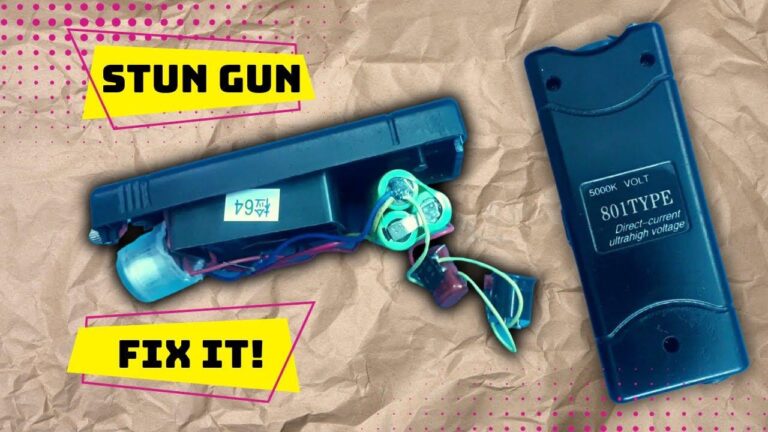Table of Contents
- Common Causes Behind a Stun Gun Failing to Power Up
- Step-by-Step Guide to Diagnosing Battery and Charging Issues
- Effective Maintenance Practices to Prevent Stun Gun Malfunctions
- When to Seek Professional Repairs or Consider Replacement Options
- To Conclude
Common Causes Behind a Stun Gun Failing to Power Up
When your stun gun refuses to power on, the issue often boils down to a few critical factors. Battery problems are the most common culprit-whether it’s due to dead batteries, improperly installed cells, or worn-out rechargeable packs. Many users overlook the importance of ensuring the battery compartment is clean and free from corrosion, which can interrupt the electrical connection. Additionally, some models have protective safety switches or locks that may inadvertently be engaged, preventing the stun gun from activating.
Another frequent cause relates to internal component malfunctions. Over time, internal wiring issues or damaged circuitry caused by drops, moisture exposure, or manufacturing defects can lead to no power output. It’s also worth checking the stun gun’s fuse, if accessible, as a blown fuse can disable the device entirely. Lastly, be mindful of environmental factors-extreme cold or heat may affect battery performance and device operation, making a quick environmental check crucial in troubleshooting efforts.
Step-by-Step Guide to Diagnosing Battery and Charging Issues
Begin by verifying the battery’s condition since a dead or degraded battery is often the root cause. Use a multimeter to check the battery voltage, ensuring it matches the manufacturer’s specified levels. If the voltage is below the acceptable range, it’s time to replace the battery. Additionally, inspect the battery terminals for any signs of corrosion or loose connections, as these can prevent the stun gun from powering up. Cleaning terminals with a cotton swab dipped in isopropyl alcohol can restore proper contact and improve charging efficiency.
Next, focus on the charging system. Confirm that the charging cable and adapter are functioning correctly by testing them with a compatible power source or another device. Look for any frayed wires or damage that could interrupt the flow of electricity. If your stun gun has an indicator light, monitor it during charging; a lack of illumination could mean the internal fuse is blown or the charging port is faulty. To rule out internal component failures, carefully inspect the circuitry for burnt components or loose solder joints, which may require professional repair or replacement.
Effective Maintenance Practices to Prevent Stun Gun Malfunctions
Regular upkeep is the cornerstone of ensuring your stun gun operates reliably when you need it most. Start by keeping the device clean-dust, moisture, and debris can accumulate on the electrodes and internal components, leading to functional issues. Use a soft, dry cloth to wipe down the exterior and avoid harsh chemicals that might degrade the casing or circuitry. Routinely inspect the stun gun for any visible signs of wear, such as cracks or loose parts, which can compromise performance.
Battery health is equally critical. Always use the manufacturer-recommended batteries and replace them before they become fully depleted to maintain optimal power output. Consider establishing a charging schedule if your stun gun has a rechargeable battery, preventing deep discharges that shorten battery lifespan. Additionally, store your device in a cool, dry place away from extreme temperatures and direct sunlight to safeguard its internal components. Implementing these practices not only extends the life of your stun gun but also guarantees it will activate reliably during an emergency.
- Clean electrodes regularly to prevent debris buildup
- Inspect the stun gun for physical damage routinely
- Use and replace batteries according to manufacturer guidelines
- Establish a regular charging routine for rechargeable models
- Store properly in a dry, temperature-controlled environment
When to Seek Professional Repairs or Consider Replacement Options
Understanding when to escalate from simple troubleshooting to professional intervention is crucial for your stun gun’s longevity and safety. If you have checked the battery, ensured proper charging, and examined all basic components without success, it might be time to consult an expert. Persistent issues such as faulty internal wiring, damaged switches, or circuit board malfunctions require specialized diagnostic tools and expertise that go beyond everyday fixes. Attempting to repair these complex problems yourself could result in further damage or void any existing warranty, so professional repairs are often the safest route.
In some cases, repair might not be the most cost-effective or reliable solution. Consider the following scenarios as indicators that replacement could be a better option:
- Repeated malfunctions: Frequent breakdowns after repairs suggest underlying issues that are costly or impractical to fix.
- Outdated technology: New stun gun models often feature enhanced safety features and improved battery life.
- Physical damage: Cracked casing, broken electrodes, or extensive water exposure can compromise functionality permanently.
To Conclude
In conclusion, a stun gun that won’t turn on can be frustrating, but with a methodical approach, most common issues can be easily identified and resolved. Whether it’s a dead battery, a faulty charging connection, or a simple safety switch being engaged, taking the time to troubleshoot your device ensures it’s ready when you need it most. If basic fixes don’t work, don’t hesitate to reach out to the manufacturer or a professional for support. Remember, regular maintenance and proper storage go a long way in keeping your stun gun reliable and effective. Stay safe and empowered!Check Our Other Blogs
- StunGun – Your Trusted Source for Stun Guns, Laws, and Self-Defense Tips
- PepperSprayLaws – Your Trusted Resource for Pepper Spray Information
- StunGunLaws – Your Trusted Guide to Stun Gun Legality and Safety





